 German Empire – Irene, Prinzess Wilhelm
German Empire – Irene, Prinzess WilhelmWW1 German Cruisers
Irene class | SMS Gefion | SMS Hela | SMS Kaiserin Augusta | Victoria Louise class | Prinz Adalbert class | SMS Prinz Heinrich | SMS Fürst Bismarck | Roon class | Scharnhorst class | SMS BlücherBussard class | Gazelle class | Bremen class | Kolberg class | Königsberg class | Nautilus class | Magdeburg class | Dresden class | Graudenz class | Karlsruhe class | Pillau class | Wiesbaden class | Karlsruhe class | Brummer class | Königsberg ii class | Cöln class
The first German protected cruisers:
Irene and Prinzessin Wilhelm (Prince William) were built respectively at Vulcan (Stettin) and Germaniawerft. They were the first cruisers (“Kreuzer”) in the German Navy. And the first protected cruisers in Germany. Still second class as they appeared, they were quite an improvement over the late 1870-1880s Bussard class, later reclassed as gunboats. At that time, German “avisos” (dispatch vessels) ruled, and the Irene class were at that time denominated “cruiser-corvettes”.
Design
Both cruisers were quite long at the time, at 98.90 m (324 ft 6 in) long (waterline), up to 103.70 meters (340 ft 3 in) overall. Beam was 14.20 m (46 ft 7 in), draft of 6.74 m (22 ft 1 in) for a standard displacement of 4,271 metric tons (4,204 long tons), and 5,027 t (4,948 long tons) fully loaded. The hull used transverse and longitudinal steel frames. The outer hull was covered with wooden planking backed by Muntz copper sheathing, all to prevent fouling. The stem was a solid piece of bronze below the waterline, the ram was made in and iron above it.
The Irene class were excellent sea boats, before the wind, handy and seaworthy even in high seas. They lost little speed when turning hard (both had their steering controlled by a single rudder.) with little roll and pitch making them excellent artillery platforms. However in heavy seas they usual only sailed at nine knots, suffering from structural weaknesses in theit forecastle. Their transverse metacentric height was .69 to .72 m (2 ft 3 in to 2 ft 4 in).
Their compound steel armoured deck amidships was wooden sheated for colonial operations in tropical waters. The crew consisted in 28 officers and 337 enlisted men, and they carried smaller boats: Two picket boats, one pinnace, two cutters, one yawl, and two dinghies.
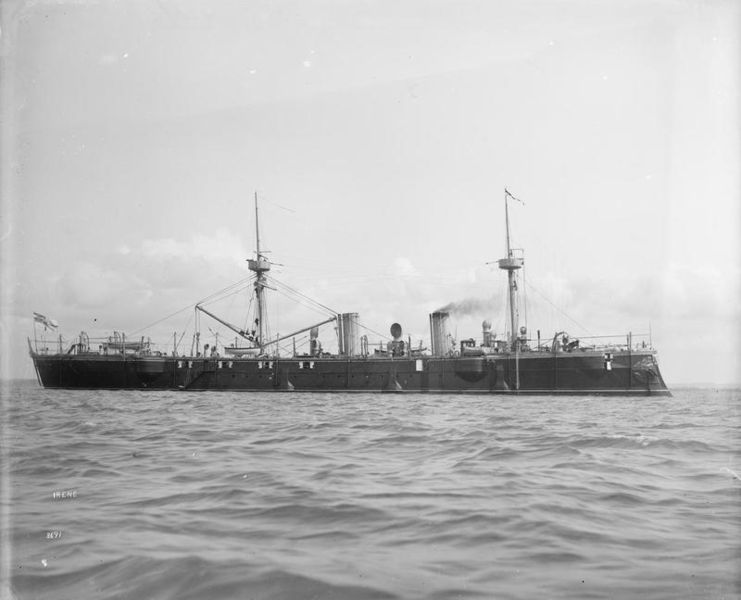
SMS Irene in 1890 – IWM
Irene class powerplant
Irene’s propulsion rested on two horizontal 2-cyl. double-expansion steam engines (VDE) with steam was provided by four coal-fired fire-tube boilers. This power was transmitted to a pair of three-bladed screws, 4.50 m (14 ft 9 in) in diameter. SMS Prinzess Wilhelm’s one differed slightly in having 4.70 m screws, with four blades. Also her boilers came from AG Germania instead of Wolfsche as on Irene. The exhausts were truncated and ducted into a pair of funnels. Total output was 8,000 metric horsepower (7,900 ihp), enough for 18 kn (33 km/h; 21 mph). The ship’s range according to their expected colonial duties was about 2,490 nautical miles (4,610 km; 2,870 mi) at 9 knots (17 km/h; 10 mph), a figure common at the time, due to the limitations of coal. Both vessels also had two electrical generators, for SMS Irene, rated for 23 kilowatts (31 hp) at 67 volts and for Prinzess Wilhelm (later, as it was the same at first) three generators for a total of 33 kW (44 hp) at 110 volts.
Armament
Irene and Prinzess W. had the same main battery, which consisted of four 15 cm RK L/30 guns, all in single pedestal mounts and with shields. For stability they were fitted in sponsons fore and aft for broadside fire, but the two forward and two aft could fire in chase and retreat. This was a common feature inherited from central batteries on ironclads. Each of these Krupp guns were supplied with 400 rounds total. They could hit in theory a target at 8,500 m (9,300 yd).
The battery was completed originally by short barrel 15 cm RK L/22 guns in single mounts alongside the broadside. Their range was limited to 5,400 m (5,900 yd) as well as their arc of fire, around 80°. To fen off torpedo boats attacks, the ships also carried six 3.7 cm revolver cannons, of which four were installed in fighting tops and the rest on the upper deck.
For close combat, both ships also carried three 35 cm (13.8 in) torpedo tubes. They had eight reloads. Two of these tubes were mounted on the deck (with traverse) and the third was fixed in the bow and below the waterline.
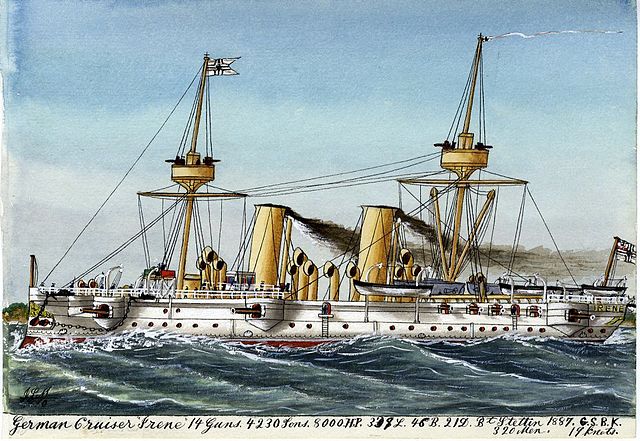
Caricature of SMS Irene by James Scott Maxwell
Protection
Protection, as said above, rested on compound steel armor. The bulk of the protection tested in the armoured deck, above the waterline, making them early protected cruisers. This main armor deck had two layers, 20 mm (0.79 in) and 30 mm (1.2 in) (total 50 mm). Its sloped downward to the belt reached 20 mm and 55 mm for 75 mm total. The coaming protecting the vitals was 120 mm (4.7 in) in total, backed with 200 mm (7.9 in) thick teak to absorb hits energy. The conning tower had walls 50 mm thick, and the roof was 20 mm in thickness. There were 10 watertight compartments to deal with torpedo hits, and a double bottom on 50% of the hull’s total length. In addition, all the sides compartments below the waterline were equipped with cork cofferdams to contain flooding. For the time they were built, from 1886, this was a very potent and innovative combination.
Construction of the two Kreuzer Korvette
SMS Irene, named after Princess Irene of Hesse and by Rhine, sister-in-law of Kaiser Wilhem II. She was the first protected cruiser in the German navy, ordered under the contract name “Ersatz Elisabeth”. She was laid down at AG Vulcan (Stettin) in 1886, launched on 23 July 1887, and fitted-out on situ to be commissioned on 25 May 1888. Her sister ship SMS Prinzess Wilhelm (“Prince William”) was ordered under the contract name “Ersatz Ariadne”. She was laid down at Germaniawerft shipyard (Kiel) the same year but launched later on 22 September 1887, and after fitting-out was commissioned on 13 November 1889, more than a year and seven months afterwards. There is no doubt for historians about the name of the class, attributed to Irene as a the clear lead ship.
Modifications of the German protected cruisers
First modernization came in 1893, before their Asiatic service, but its nature is unclear. As artillery progressed fast, they were taken in hands in Wilhelmshaven at their return from the Asia squadron between 1899 and 1905 (by combining the two ships) for a refit. Their armament was improved with four brand new 15 cm SK L/35 guns in single pedestal mounts in sponsons fore and aft, which range reached 10,000 m (11,000 yd). This was completed by the removal of all short barrel 15 cm guns, replaced by right QF 10.5 cm (4.1 in) SK L/35 guns. Three were aft each side of the rear mast, one amidship between funnels and the last one in a bow barbette. Also to deal more efficiently with TBs, six 5 cm (2 in) SK L/40 QF guns were added on the decks. The mast had a thicker base, supporting fighting tops in which were mounted QF guns, whereas other were installed either side of the bridge forward or the rear superstructure aft. The crew composition was also changed, with 17 officers while enlisted men grew to to 357. Irene was taken in hands at Wilhelmshaven for another refit, in 1903-1907, and Prinzess W. in 1899-1902.
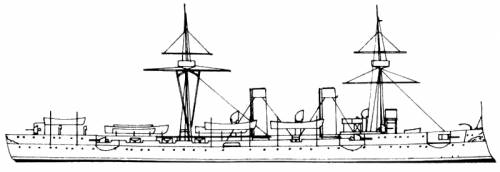
SMS Irene after refit in 1900.
Specifications in 1905 |
|
| Dimensions | 103.70 m (340 ft 3 in) oa x 14.20 m (46 ft 7 in) x 6.74 m (22 ft 1 in) |
| Displacement | 4,271 t (4,204 long tons), Full load: 5,027 t (4,948 long tons) |
| Crew | 27 officers and 337 sailors |
| Propulsion | 2 shafts, 4 × fire-tube boilers VDE, 8,000 PS (7,900 ihp) |
| Speed | 18 knots (33 km/h; 21 mph), Range: 2,490 nmi (2,870 mi) at 9 knots |
| Armament | 4 × 150, 8 × 105, 6 × 37 mm, 3 × 350 mm TTs |
| Armor | Decks 50-75 mm, gunshields 50 mm, Conning tower 50 mm |
Service
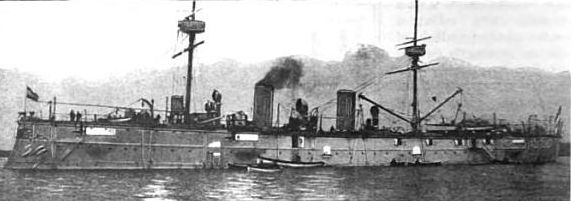
Both Irene and Prinzess Wilhelm saw extensive service due to their active life; Irene at first was a prestige ship in the Navy and often escorted Kaiser Wilhelm II’s yacht on European cruises, so it’s became famous as a showship, also frequently visited by foreign dignitaries. Irene also served in East Asian waters as Prinzess Wilhelm, notably taking part in the capture of Kiaochou Bay in 1897. They were at the basis of the future East Asia Squadron which was created around them. Both were present in the Philippines in 1898, the admiral hoping to seize another base there.
After modernization the ships were still active in 1914, although retired from front-line duties. Irene was converted as a submarine tender and served until the war ended, while Prinzess Wilhelm was a mine hulk and was also scrapped after the war.
SMS Irene
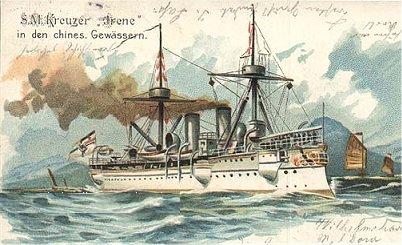
A postcard of the Asian squadron showing SMS Irene.
Irene was the first protected cruiser built by the German navy and started her duty on 25 May 1888, joining the armada sent in UK to celebrate the coronation of Kaiser Wilhelm II. At her return she was assigned to the frontline 1st Division, alongside the ironclads Sachsen and Baden and casemate ironclad SMS Oldenburg, and served as as a reconnaissance and screening ship. Prince Heinrich commanded the Division, and SMS Irene was his flagship. Training manoeuvers were made in the North Sea (Rear Admiral Friedrich Hollmann) and both divisions went into the Mediterranean for the winter cruise, escorting the Kaiser’s yacht SMS Hohenzollern to various ports for official visits, notably Turkey and Italy, Athens and Venice. They were back in Germany in April 1890.
In August a new escort started for Irene, this time to participate in the Cowes Regatta. Both cruisers later sailed to Helgoland, just transferred with a ceremony from Britain. The entire German fleet paraded at this occasion. By late November 1894, SMS Irene sailed to Casablanca, showing her guns after the murder of a German businessman there. She was sent in Asia, becoming the fulcrum of German naval presence there after the First Sino-Japanese War. She became the flagship of the new Asian division under Rear Admiral Paul Hoffmann, with three older cruisers. In 1895, SMS Prinzess Wilhelm joined her, as well as the rebuilt SMS Kaiser, the cruiser Cormoran, corvette Arcona, and gunboat Iltis. This force was a reflection of the Kaiser’s will to be present in the regio,, disputed by great colonial powers of the time, hoping to make some territorial gains.
In 1896, Otto von Diederichs arrived at the head of the East Asian Cruiser Division and in 1897, Irene was refitted in Hong Kong and was back in the fleet on 3 December. So she missed Von Diederichs seizure of the Kiaochou Bay concession, one of the greatest achievement of the Cruiser Division so far. With new reinforcements, this fleet became the famous East Asia Squadron. Irene was the flagship of the 1st Division of this new Squadron and in the spring of 1898, she was in Shanghai for maintenance. Of course, the squadron was present during the Spanish–American War that year. SMS Irene was sent in Manila after the Battle, on 6 May. In June she was joined by Kaiserin Augusta but several days later, SMS Irene stopped in Manila Bay by the American revenue cutter Hugh McCulloch.
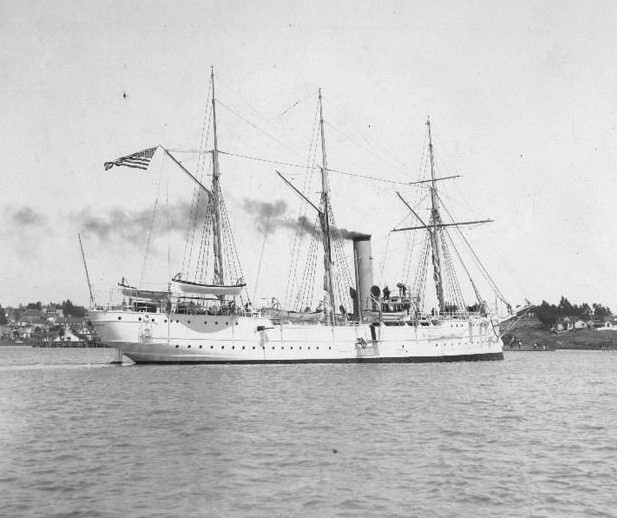
The revenue cutter Mc Culloch
In July, Rear-admiral Diederichs dispatched Irene to patrol the waters of Subic Bay and to evacuate potential nationals during the Filipino insurgency. Off Isla Grande, she encountered the Companie de Filipinas, a recently insurgent ship threatening the Spanish garrison at Isla Grande. The rebel commander called fora parley onboard Irene, but Captain Obenheimer informed him he considered any hostilities as piracy under international law. This was enough to dissuade the insurgents of any action, as their ship was no match for the cruiser. Captain Obenheimer wold later inspect the Spanish garrison and later, the rebel base in Olongapo. Irene evacuated noncombatants from Isla Grande and met on her way the American warships Raleigh and Concord, making a salutation, but the American press back home made this encounter a near fight.
This prompted Diederichs to retire Irene from the area and deflate growing tensions of the German presence in these waters. She debarked her passengers to Manila and departed the Philippines for good, relieving Arcona in Kiaochou. She conducted training there but was back to Manila in November for a brief stop, replaced by Kaiserin Augusta. She steamed back to Germany in 1901 and two years later was extensively refitted at the Imperial Shipyard of Wilhelmshaven. She was recommissioned in 1905 but stayed in home waters for reduced training, and was eventually stricken before the war, on 17 February 1914 like her sister ship. It was decided to convert her as a submarine tender in Kiel. In 1916, she was transferred to Wilhelmshaven, and was anchored there until the end of the war. Due to her age and role, she was excluded by the peace talks and on 26 November 1921, sold for scrap, BU in 1922 on situ.
SMS Prinzess Wilhelm
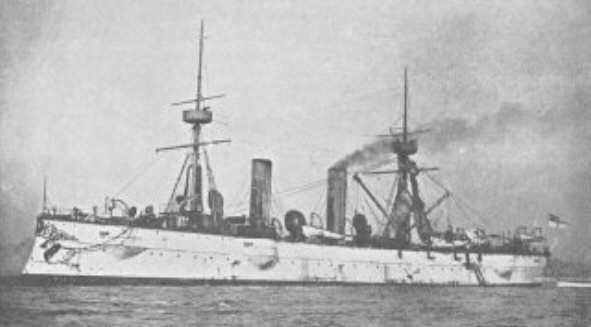
SMS Prinzess Wilhelm was the second protected cruiser of German navy and her service started, after a crash cruise and training in 1888-89 by the large scame maneuvers of 1890, playing the opposing force with several corvettes. By September 1892, she was in Genoa as Germany’s ambassador for the 400th anniversary of the voyage of Christopher Columbus, only German ship there. In 1894 the autumn maneuvers took place, in which SMS Prinzess Wilhelm was the reconnaissance flotilla’s flagship. In January 1895, she sailed to joint Irene in Asia and reinforce the Cruiser Division. By June 1896 she was in the cruiser division, under command of no other than Alfred von Tirpitz. In November 1896 she was in long maintenance for her powerplant issues.
By June 1897, Rear Admiral Otto von Diederichs took command of her Division and with Irene, and Arcona was stationed in Chefoo for gunnery training. Diederichs raised his mark onboard the modernized ironclad SMS Kaiser, and held a series of ceremonial visits with his captains. In July, Diederichs was on Prinzess Wilhelm for a state visit in Peking and negotiations for a permanent naval base. He tried to obtain the port of Kiaochou, but this was refused. He took his time mater to report extensively on the Taku Forts, guarding the entrance to Peking.
In October, Diederichs planned to rotate his ships for maintenance and Prinzess Wilhelm was to be sent in Shanghai but instead he conducted both Prinzess Wilhelm and Kaiser to Kiaochou for an autumn gunnery training. Prinzess Wilhelm was to be stationed in the port during the winter, but when this was denied by Chinese authorities, Diederichs used as a casus belli the murder of two German priests on 6 November in Shangtung. Her planned with his two ships a full attack on Kiaochou, shelling the fortification, and later joined by SMS Cormoran. By 10 November, the attack was ready and planned for the night of the 12. The three ships formed a battle line that was to surge into the harbor on the morning of 14 November. Crews also were to form a landing party and complete the seizure of the harbor just before the intense shelling started, with some 700 officers and men. They were landed on the main pier in the harbor and the Chinese were caught completely by surprise. In two hours it was folded and Diederichs had the Chinese commander, General Chang was arrested and forced to order a withdrawal of his forces while the Imperial flag was raised. SMS Prinzess Wilhelm fired a 21-gun salute. The landing party remained as a garrison while and several 3.7 cm guns of the cruisers were landed to provide defensive artillery.
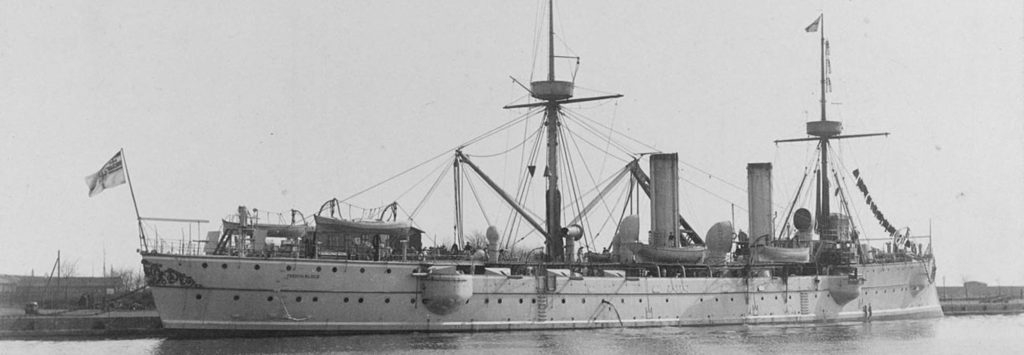
Diederichs requested reinforcements and a second division was authorized, in what became the East Asia station, stationed in this newly seize port. Prinzess Wilhelm became flagship of the 1st Division of this new Squadron and in November, Diederichs became vice admiral with overall command of German naval forces in Asia. Chinese forces at the end of the month tried to retake the port; but were rebuffed by Prinzess Wilhelm’s and Kaiser’s strong artillery support. General Chang was arrest after attempting a subversion of the German occupation. After the Chinese rout, 50 men from Prinzess Wilhelm’s were sent as a defensive party at Chi-mo to fend off Chinese raids there.
In the Spring of 1898, as the Spanish-American war just was about to end, Manilla was now in US hands, and SMS Prince Heinrich became the admiral’s flagship as kaiser was sent in maintenance to Nagasaki. Kaiserin Augusta was sent in Nagasaki, as temporary flagship and later Prinzess Wilhelm and Kaiser joined her to sail in June for the Philippines with Irene and Cormoran. Prinzess Wilhelm coaled in Mariveles en route and embarked additional crew from the transport Darmstadt. On 9 August, the American squadron ordered neutrals to leave and the Germans returned to Mariveles. SMS Prinzess Wilhelm in the Philippines for thet German nationals, replaced by Arcona in October but in November, after Kaiser ran aground Prinzess Wilhelm became the flagship. She returned in germany by 1899, was in drydock at Wilhelmshaven for modernization until 1902 but stricken in February 1914 and used during the war as a mine hulk in Danzig, Kiel and Wilhelmshaven in succession. Too old to become a prize or part of the peacetime treaty navy, she was sold on 26 November 1921, and broken in situ like her sister.
Src/Read More
Conway’s all the world fighting ships 1860 -1905.
Cooling, Benjamin Franklin (2007). USS Olympia: Herald of Empire.
Gottschall, Terrell D. (2003). By Order of the Kaiser, Otto von Diederichs and the Rise of the Imperial German Navy 1865–1902.
Gröner, Erich (1990). German Warships: 1815–1945. Vol. I: Major Surface Vessels.
Sondhaus, Lawrence (1997). Preparing for Weltpolitik: German Sea Power Before the Tirpitz Era.
Röhl, John C. G. (2004). Wilhelm II: The Kaiser’s Personal Monarchy, 1888–1900.
//en.wikipedia.org/wiki/Irene-class_cruiser
//www.fr.naval-encyclopedia.com/1ere-guerre-mondiale/Kaiserliche-Marine.php#crois

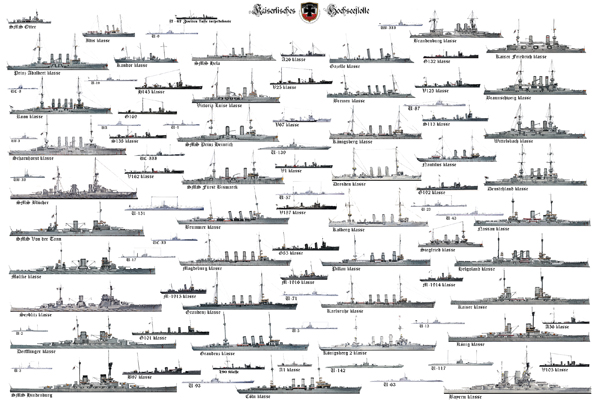
 Latest Facebook Entry -
Latest Facebook Entry -  X(Tweeter) Naval Encyclopedia's deck archive
X(Tweeter) Naval Encyclopedia's deck archive Instagram (@navalencyc)
Instagram (@navalencyc)





 French Navy
French Navy Royal Navy
Royal Navy Russian Navy
Russian Navy Armada Espanola
Armada Espanola Austrian Navy
Austrian Navy K.u.K. Kriegsmarine
K.u.K. Kriegsmarine Dansk Marine
Dansk Marine Nautiko Hellenon
Nautiko Hellenon Koninklije Marine 1870
Koninklije Marine 1870 Marinha do Brasil
Marinha do Brasil Osmanlı Donanması
Osmanlı Donanması Marina Do Peru
Marina Do Peru Marinha do Portugal
Marinha do Portugal Regia Marina 1870
Regia Marina 1870 Nihhon Kaigun 1870
Nihhon Kaigun 1870 Preußische Marine 1870
Preußische Marine 1870 Russkiy Flot 1870
Russkiy Flot 1870 Svenska marinen
Svenska marinen Søværnet
Søværnet Union Navy
Union Navy Confederate Navy
Confederate Navy Armada de Argentina
Armada de Argentina Imperial Chinese Navy
Imperial Chinese Navy Marinha do Portugal
Marinha do Portugal Mexico
Mexico Kaiserliche Marine
Kaiserliche Marine 1898 US Navy
1898 US Navy Sovietskiy Flot
Sovietskiy Flot Royal Canadian Navy
Royal Canadian Navy Royal Australian Navy
Royal Australian Navy RNZN Fleet
RNZN Fleet Chinese Navy 1937
Chinese Navy 1937 Kriegsmarine
Kriegsmarine Chilean Navy
Chilean Navy Danish Navy
Danish Navy Finnish Navy
Finnish Navy Hellenic Navy
Hellenic Navy Polish Navy
Polish Navy Romanian Navy
Romanian Navy Turkish Navy
Turkish Navy Royal Yugoslav Navy
Royal Yugoslav Navy Royal Thai Navy
Royal Thai Navy Minor Navies
Minor Navies Albania
Albania Austria
Austria Belgium
Belgium Columbia
Columbia Costa Rica
Costa Rica Cuba
Cuba Czechoslovakia
Czechoslovakia Dominican Republic
Dominican Republic Haiti
Haiti Hungary
Hungary Honduras
Honduras Estonia
Estonia Iceland
Iceland Eire
Eire Equador
Equador Iran
Iran Iraq
Iraq Latvia
Latvia Liberia
Liberia Lithuania
Lithuania Mandchukuo
Mandchukuo Morocco
Morocco Nicaragua
Nicaragua Persia
Persia San Salvador
San Salvador Sarawak
Sarawak Uruguay
Uruguay Venezuela
Venezuela Zanzibar
Zanzibar Warsaw Pact Navies
Warsaw Pact Navies Bulgaria
Bulgaria Hungary
Hungary

 Bundesmarine
Bundesmarine Dutch Navy
Dutch Navy Hellenic Navy
Hellenic Navy Marina Militare
Marina Militare Yugoslav Navy
Yugoslav Navy Chinese Navy
Chinese Navy Indian Navy
Indian Navy Indonesian Navy
Indonesian Navy JMSDF
JMSDF North Korean Navy
North Korean Navy Pakistani Navy
Pakistani Navy Philippines Navy
Philippines Navy ROKN
ROKN Rep. of Singapore Navy
Rep. of Singapore Navy Taiwanese Navy
Taiwanese Navy IDF Navy
IDF Navy Saudi Navy
Saudi Navy Royal New Zealand Navy
Royal New Zealand Navy Egyptian Navy
Egyptian Navy South African Navy
South African Navy






























 Ukrainian Navy
Ukrainian Navy dbodesign
dbodesign